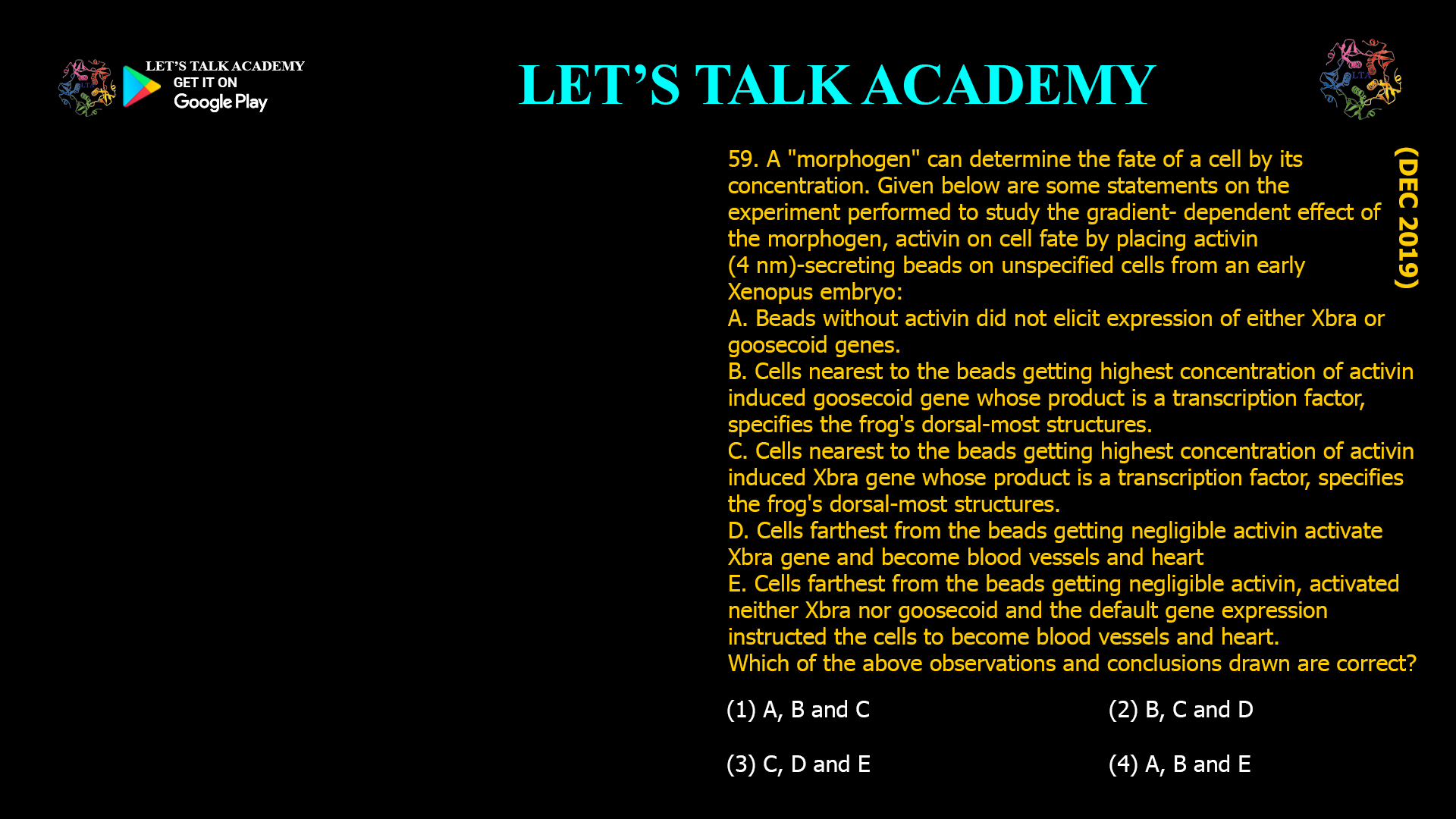69. The flowering repressor gene that is responsible for the vernalization requirement in Arabidopsis is: (1) CONSTANS (CO) (2) FLOWERING LOCUS D (FD) (3) FLOWERING LOCUS T (FT) (4) FLOWERING […]
Category: CSIR NET Life Science Previous Year Questions and Solution on Basic Concepts of Development
CSIR NET Life Science Previous Year Questions and Solutions on Basic Concepts of Development
If you are preparing for CSIR NET Life Science, a strong foundation in the Basic Concepts of Development is essential. These concepts form the backbone of Developmental Biology and are frequently tested in the exam. Practicing previous year questions along with their solutions can help aspirants understand exam patterns, focus on important topics, and improve problem-solving skills.
This article provides a comprehensive guide on CSIR NET Life Science previous year questions and solutions related to Basic Concepts of Development, along with preparation strategies and resources.
What are the Basic Concepts of Development?
Basic Concepts of Development include the fundamental principles that govern how organisms grow, differentiate, and develop from a single cell to a fully functional organism. In the CSIR NET syllabus, the key areas include:
-
Cell differentiation and fate determination – How cells become specialized
-
Induction and competence – Role of signals in guiding development
-
Morphogen gradients – Spatial regulation of tissue patterning
-
Stem cells and regeneration – Understanding totipotency, pluripotency, and multipotency
-
Gene regulation in development – Role of transcription factors and signaling pathways
-
Developmental plasticity – How environment and signals influence development
Mastery of these concepts is crucial because CSIR NET questions often test both conceptual understanding and application.
Importance of Practicing Previous Year Questions
Solving previous year questions (PYQs) is a key strategy for CSIR NET Life Science preparation. Here’s why:
-
Exam Familiarity: Understand the type of questions asked on basic developmental concepts.
-
Identify High-Yield Topics: Frequent questions indicate important areas.
-
Time Management: Learn to solve questions accurately within a limited time.
-
Self-Assessment: Evaluate your understanding and identify weak areas.
Sample Previous Year Questions on Basic Concepts of Development
Here are some examples of CSIR NET Life Science previous year questions on basic concepts of development:
-
Question: Define induction in developmental biology.
Solution: Induction is a process in which one group of cells (the inducer) influences the fate or differentiation of another group of cells (the responder) through chemical signals. -
Question: What is the role of morphogens in embryonic development?
Solution: Morphogens are signaling molecules that form concentration gradients and determine cell fate based on their position. Example: Bicoid protein in Drosophila anterior-posterior patterning. -
Question: Explain the difference between totipotent, pluripotent, and multipotent cells.
Solution:-
Totipotent: Can form all cell types, including extra-embryonic tissues (e.g., zygote).
-
Pluripotent: Can form all embryonic cell types but not extra-embryonic tissues (e.g., embryonic stem cells).
-
Multipotent: Can form multiple related cell types (e.g., hematopoietic stem cells).
-
-
Question: What is competence in developmental biology?
Solution: Competence refers to the ability of a group of cells to respond to inductive signals. Only competent cells can differentiate in response to an inducer. -
Question: Name one gene that regulates anterior-posterior axis formation in vertebrates.
Solution: Hox genes are key regulators of anterior-posterior axis formation in vertebrate development.
How to Prepare Basic Concepts of Development for CSIR NET
-
Understand Core Concepts: Focus on induction, competence, morphogens, cell fate, and stem cells.
-
Use Diagrams: Draw diagrams for processes like morphogen gradients, induction, and cell differentiation. Visual learning helps in MCQs and diagram-based questions.
-
Solve MCQs and PYQs: Practice previous year questions to reinforce learning.
-
Relate Genes and Pathways: Understand signaling pathways and gene regulation, including Hox genes, Wnt, Notch, and BMP pathways.
-
Revision: Regularly revise key terms, processes, and diagrams for long-term retention.
Recommended Resources
-
Developmental Biology by Scott F. Gilbert – Comprehensive textbook for conceptual clarity.
-
Lippincott’s Illustrated Reviews: Developmental Biology – Excellent for diagrams and concise explanations.
-
CSIR NET Previous Year Question Papers PDF – For practice and exam pattern analysis.
-
Online Test Series and Video Lectures – Useful for learning mechanisms and improving problem-solving speed.
Conclusion
Mastering Basic Concepts of Development is vital for CSIR NET Life Science aspirants. Regular practice of previous year questions and solutions strengthens conceptual understanding, improves exam confidence, and enhances accuracy.
Tip: Dedicate 20–30 minutes daily to solving PYQs on development, make concise notes, and practice diagrams to maximize your score.

Megasporogenesis and Female Gametophyte Development in Angiosperms: Clarifying Common Misconceptions
























































































































































































